Emanuel Phillips Fox – Prolific Australian Impressionist
Not long ago we presented a post about Ethel Carrick Fox, one of the artists in the Know My Name series on Australian women artists. (Click here if you missed it).
In that post we mentioned that Ethel married a man named Emanuel Phillips Fox, who was also an Australian Impressionist artist. Despite the fact that he died at only age 50, and she lived another 36 years after his death, it is actually his work that is far more well-known than hers, here in Australia, at least. Part of the reason for that is Ethel spent a lot of time promoting his work rather than her own, and by all accounts, was the stronger personality of the two.
So let us have a look at his work, by comparison.
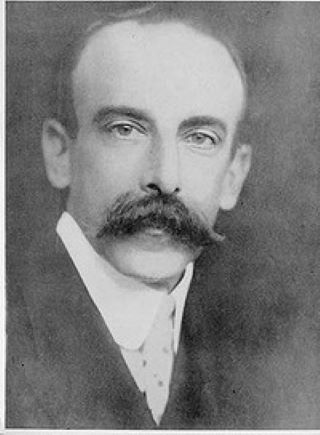
Emanuel Phillips Fox was born on 12 March 1865 at Fitzroy, Melbourne. He was the seventh child of Alexander Fox, from London, and his Sydney-born wife Rosette, née Phillips. As we’ve commented before, he is known as Emanuel Phillips, E. Phillips Fox and E. Fox. I don’t know if he was known by both surnames from birth, or whether he took his mother’s maiden name at some point in adulthood, as was a common trend of the time (as we’ve commented before).
Fox finished school at age 15 and then went to study at the National Gallery together with fellow students Rupert Bunny, Frederick McCubbin, and William Longstaff. He won awards for landscape painting at the gallery students' exhibitions in 1884 and 1886. 1 He qualified as a drawing teacher and taught at a number of suburban design schools while painting landscapes around Melbourne and in Gippsland.
In 1887 he left Melbourne for Paris, and studied at the Académie Julian and was later admitted to the prestigious École des Beaux-Arts. 2
He painted en plein air in the artists' communities at Etaples and in Brittany and visited Giverny. In 1890 he settled at St Ives in Cornwall, as it was one of the key centres of en plein air painting in England.
Fox returned to Melbourne in October 1892. He joined the Victorian Artists' Society and was a vocal council-member and exhibitor between 1893 and 1900. He launched one-man shows in 1892 and 1900-01, contributed to major displays in Sydney, Adelaide and Bendigo and was represented in the Australian Exhibition at the Grafton Galleries in London in 1898. Although he gained an international reputation in the art world, his commissions were largely confined to portraits. In 1893 he and a friend named Tudor St. George Tucker established the Melbourne School of Art where students were introduced to French academic practices. They taught en plein air painting at Charterisville, near Heidelberg, in Melbourne, incorporating some aspects of Impressionist techniques which Fox had had exposure to in Europe. It is said to have been the most vibrant art school in Melbourne in the 1890s.1
In 1900 the trustees of the National Gallery of Victoria (NGV) chose Fox to paint 'The landing of Captain Cook at Botany Bay', under the William Gillbee bequest. This bequest required him to travel to England to paint a picture of historical significance for which he would receive a share of the bequest amount of £1000. He departed in March 1901 and finished the painting in 1902. This is a very well-known painting which is still held by the NGV.
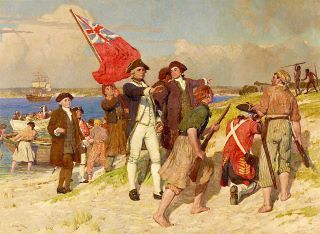
After a visit to Paris, he went back to the open-air artists’ colony at St. Ives, Cornwall, which he loved. It is there that he met his future wife, Ethel Carrick, in 1902 or 1903.
On 9 May 1905 at St Peter's Church, Ealing, London, Fox married Ethel Carrick; they then lived in Paris until 1913, travelling widely in Europe and northern Africa. These were fertile years in Fox's career, and his art celebrated a way of life that was leisured and elegant. From 1890 he had contributed works to the Salon, and in 1894 won a gold medal with his portrait 'My Cousin'. 1
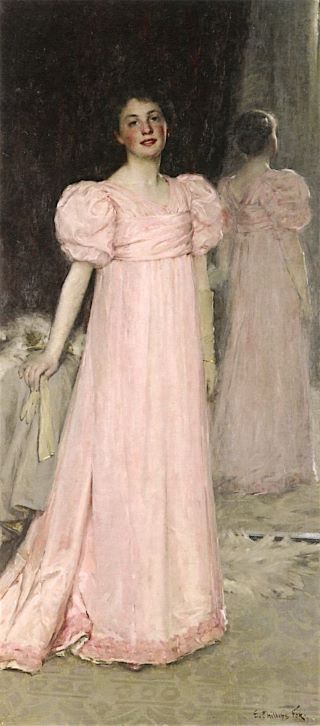
Fox became a member of the International Society of Sculptors, Painters and Gravers, an associate of the Société Nationale des Beaux-Arts in 1907 and its sociétaire in 1910.1 He was the first Australian-born full member of the Societe Nationale des Beaux-Arts in 1910, which had broken away from The Salon.
Phillips Fox and his wife came back to Australia in 1908 and 1913, exhibiting and painting in Melbourne, Sydney and Adelaide. The outbreak of war brought them back to Melbourne from a trip to Tahiti, and in 1915 they helped to organize an art union in aid of war funds and the French Red Cross.
Ethel and Emanuel didn't have any children. On 8 October 1915 Fox died of cancer in hospital at Fitzroy, and was buried in Brighton cemetery. 1
Emanuel Phillips Fox is said to have been the leader of the second wave of The Heidelberg School, which we have also featured here on the blog. When compared with Charles Conder and Sir Arthur Streeton, Fox shows more fascination with the "effects of dappled light" than to the "sunny vistas" one finds in the other two painters' Heidelberg paintings. He is described as an artist who "remained committed to a late nineteenth century aesthetic that paid homage to Impressionism while retaining the tonal values of academic realism".3
You might care to click on the bookmark below to look at more of his paintings. Do you agree with the assessment above?

To finish with, as an aside, regular readers may remember that we have featured a number of posts about various members of the very talented Boyd family. You can find these posts in the Tag Cloud in the Australian Artists category if you click here.
There is an interesting connection of the Boyds with Emanual Phillips Fox, via a friend of Emanuel’s named Edith Anderson. She features in a number of his paintings, including Nasturtiums, The Green Parasol, and On The Balcony, (below), all painted in 1912. She was a former student of Fox’s and they became good friends. She was an eye catching model for his paintings as her red hair stands out - it was so unusual.
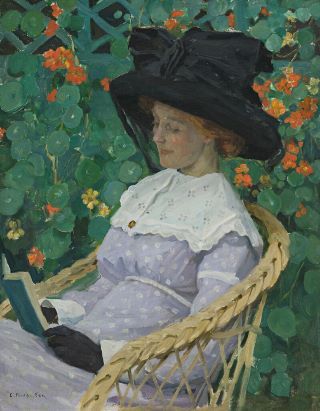
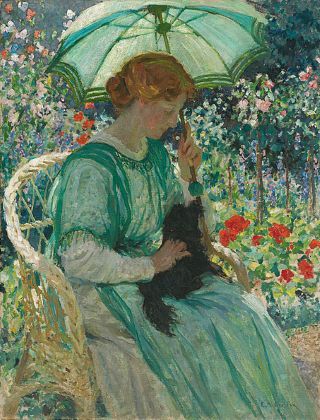
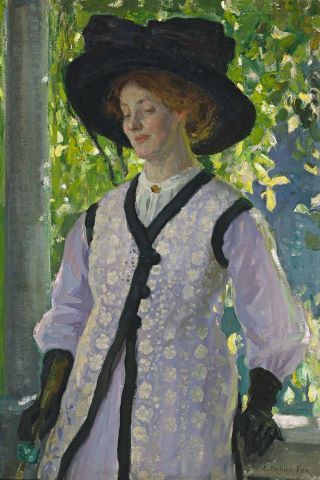
Emanuel was also a friend of Penleigh Boyd, and he introduced them to each other. Penleigh was attracted by her rich auburn hair and grey-green eyes—both of which were very fashionable at the time." 3
The two married in October 1912. Their son, Robin Boyd, became one of Australia's best known architects and their nephew, Arthur Boyd, one of Australia's best known painters.
Do you like the work of Emanuel Phillips Fox and Ethel Carrick? Can you see similarities in their styles, or do you think they managed to maintain their individuality despite their close relationship? Do let us know your thoughts!
Footnotes
With thanks to
- Australian Dictionary of Biography, https://adb.anu.edu.au/biography/fox-emanuel-phillips-6228
- Art Gallery of New South Wales
- Wikipedia
